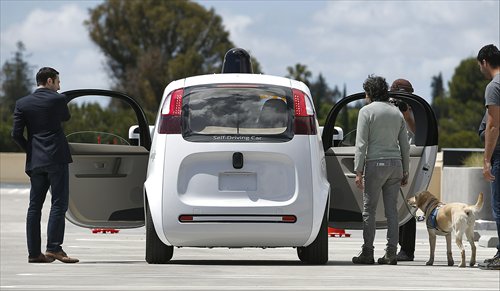HOME >> SCI-TECH
Gear up for driverless future
Source:Reuters-Global Times Published: 2016/1/15 9:41:39

Riders enter the Google's new self-driving prototype car for a ride at Google campus in Mountain View, the US in May 2015. Photo: IC
Google said on Tuesday the rate of software failures in its self-driving cars was declining as the technology was learning from its mistakes, bringing the tech company closer to its goal of fully autonomous vehicles.
In 424,000 miles of autonomous driving, Google said its cars had experienced 272 episodes in which the human test driver had to assume control of the vehicle, an occurrence called "disengagement," when the autonomous technology failed.
"As we continue to develop and refine the self-driving software, we are seeing fewer disengagements" despite more miles driven, Google said in a 33-page report submitted by law to the California Department of Motor Vehicles (DMV) on December 31.
California regulations call for test drivers and steering wheels in autonomous vehicles.
Google's development of self-driving cars has spurred outsized interest around the world, but the company best known for search has disclosed little about its strategy, business plans or ultimate goals.
Without the need to watch the road, people in cars will talk on phones, watch entertainment, purchase consumer goods, among many other options, providing valuable data to Google.
Refining technology
The report, covering the period September 24, 2014, when Google began testing on the roads of Palo Alto, California, to November 30, 2015, found disengagements occurred about every 785 miles in the fourth quarter of 2014. A year later, that had expanded to 5,318 miles between episodes.
Eighty-nine percent of disengagements occurred on city streets, where more obstacles and stop-and-go traffic make autonomous driving more difficult.
Project director Chris Urmson said Google deliberately tests cars in different weather and times of the day, which explained why some months saw more episodes than others.
Google, now a unit of parent company Alphabet Inc, said it kept the threshold for measuring disengagements low to gather as much data as possible to refine the technology.
There were another 69 episodes in which the test driver chose to take control of the vehicle rather than the car signaling to the driver to take control.
Using a simulator to replay the situation, Google found in 13 of these instances its cars would have hit another object had the test driver not taken control. Google said two involved traffic cones, and three were due to "another driver's reckless behavior."
Urmson said the California DMV had not seen the report when it issued draft rules in December restricting how autonomous vehicles could operate for the next three years.
Seeking partnerships
In order to accelerate its work on self-driving cars, Google wants to form more partnerships with established automakers and suppliers this year.
John Krafcik, the newly hired president of the Google self-driving car project, did not mention any automakers by name. However, appearing at a media conference at the Detroit auto show, Krafcik surveyed a room packed with hundreds of auto industry executives and said: "We hope to work with many of you guys."
Google officials have said previously the Internet search company does not want to build vehicles, but instead supply the software and mapping to allow a car to safely navigate busy streets and highways.
"No one goes this alone," Krafcik said. "We are going to be partnering more and more and more." He said he hopes to form more alliances this year.
Google has worked with automotive suppliers and contract manufacturers to build a small fleet of prototype self-driving cars; small, light pod-cars that look nothing like the sport utility vehicles and pickups on display at the Detroit show.
Google, major global automakers and several auto technology companies such as Delphi Automotive Plc, Continental AG and Mobileye NV are jockeying to define and lead the development of vehicles that use machine vision, sophisticated maps and artificial intelligence to take over for error-prone human drivers.
Krafcik said that he believed partially automating the operation of a car, requiring drivers to take command under certain conditions, can create safety problems, a key point on which Google and most automakers differ.
The car "has to shoulder the whole burden," he said.
Most automakers, including General Motors Co, Tesla Motors Inc, Daimler AG, and Nissan Motor Co, are pushing to get cars on the road that allow hands-free driving under certain conditions, but require the driver to take over in more complex situations such as city driving.
Posted in: Feature